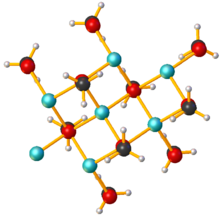Chemistry:Sodium methoxide

| |
| Names | |
|---|---|
| IUPAC name
Sodium methoxide
| |
| Other names
Sodium methylate
| |
| Identifiers | |
3D model (JSmol)
|
|
| ChemSpider | |
PubChem CID
|
|
| UNII | |
| |
| |
| Properties | |
| CH3NaO | |
| Molar mass | 54.02 g/mol |
| Appearance | White solid |
| Melting point | 127 °C (261 °F; 400 K) |
| Boiling point | 350 °C (662 °F; 623 K)[1] (decomposition) |
| Reacts with water | |
| Solubility | Soluble in ethanol, methanol Insoluble in hydrocarbons |
| Structure | |
| Hexagonal | |
| Hazards | |
| Safety data sheet | Sigma[2] |
| GHS pictograms |   
|
| GHS Signal word | Danger |
| H251, H302, H314[2] | |
| P235+410, P280, P305+351+338, P310[2] | |
Except where otherwise noted, data are given for materials in their standard state (at 25 °C [77 °F], 100 kPa). | |
| Infobox references | |
Sodium methoxide is the simplest sodium alkoxide. With the formula CH
3ONa, it is a white solid, which is formed by the deprotonation of methanol. It is a widely used reagent in industry and the laboratory. It is also a dangerously caustic base.
Preparation and structure
Sodium methoxide is prepared by treating methanol with sodium:
- 2 Na + 2 CH
3OH → 2 CH
3ONa + H
2
The reaction is so exothermic that ignition is possible. The resulting solution, which is colorless, is often used as a source of sodium methoxide, but the pure material can be isolated by evaporation followed by heating to remove residual methanol.
As a solid, sodium methoxide is polymeric, with sheet-like arrays of Na+
centers, each bonded to four oxygen centers.[3]
The structure, and hence the basicity, of sodium methoxide in solution depends on the solvent. It is a significantly stronger base in DMSO where it is more fully ionized and free of hydrogen bonding.[4]
Applications
Organic synthesis
Sodium methoxide is a routinely used base in organic chemistry, applicable to the synthesis of numerous compounds ranging from pharmaceuticals to agrichemicals.[4] As a base, it is employed in dehydrohalogenations and various condensations.[5] It is also a nucleophile for the production of methyl ethers.[6]
Industrial applications
Sodium methoxide is used as an initiator of anionic addition polymerization with ethylene oxide, forming a polyether with high molecular weight.[7] Biodiesel is prepared from vegetable oils and animal fats (fatty acid triglycerides) by transesterification with methanol to give fatty acid methyl esters (FAMEs). Sodium methoxide acts as a catalyst for this reaction, but will combine with any free fatty acids present in the oil/fat feedstock to form soap byproducts.
Stability
The solid hydrolyzes in water to give methanol and sodium hydroxide. Indeed, samples of sodium methoxide are often contaminated with sodium hydroxide, which is difficult to detect. The compound absorbs carbon dioxide from the air to form methanol and sodium carbonate, thus diminishing the alkalinity of the base.
- CH
3ONa + CO
2 + H
2O → 2 CH
3OH + Na
2CO
3
Commercial batches of sodium methoxide show variable levels of degradation, and were a major source of irreproducibility when used in Suzuki reactions.[8]
Safety
Sodium methoxide is highly caustic and reacts with water to give methanol, which is toxic and volatile.
NFPA 704
The ratings for this substance vary widely.
| Rating | |||||
|---|---|---|---|---|---|
| Source | State of Connecticut[9] | DuPont[10] | Pharmco AAPR[11] | ScienceLab[12] (Both ratings on same sheet) | |
See also
- Methoxide
- Biodiesel production
- Sodium ethoxide
References
- ↑ Chandran, K.; Kamruddin, M.; Ajikumar, P.K. et al. (2006). "Kinetics of thermal decomposition of sodium methoxide and ethoxide". Journal of Nuclear Materials 358 (2–3): 111–128. doi:10.1016/j.jnucmat.2006.07.003. ISSN 0022-3115. Bibcode: 2006JNuM..358..111C.
- ↑ 2.0 2.1 2.2 Sigma-Aldrich Co., Sodium methoxide. Retrieved on 2022-03-21.
- ↑ Weiss, E. (1964). "Die Kristallstruktur des Natriummethylats" (in de). Zeitschrift für Anorganische und Allgemeine Chemie 332 (3–4): 197–203. doi:10.1002/zaac.19643320311.
- ↑ 4.0 4.1 El-Kattan, Y.; McAtee, J.; Bessieres, B. (2006). "Sodium Methoxide". Encyclopedia of Reagents for Organic Synthesis. New York: John Wiley & Sons. doi:10.1002/047084289X.rs089m.pub2. ISBN 0471936235.
- ↑ Curtis, O. E., Jr.; Sandri, J. M.; Crocker, R. E.; Hart, H. (1958). "Dicyclopropyl ketone". Organic Syntheses 38: 19. doi:10.15227/orgsyn.038.0019. http://www.orgsyn.org/demo.aspx?prep=cv4p0278.; Collective Volume, 4, pp. 278
- ↑ Reverdin, F. (1927). "3,5-Dinitroanisole". Organic Syntheses 7: 28. doi:10.15227/orgsyn.007.0028. http://www.orgsyn.org/demo.aspx?prep=cv1p0219.; Collective Volume, 1, pp. 219
- ↑ Bailey, Frederick E.; Koleske, Joseph V. (2000). "Polyoxyalkylenes". Ullmann's Encyclopedia of Industrial Chemistry. doi:10.1002/14356007.a21_579. ISBN 3527306730.
- ↑ Wethman, Robert; Derosa, Joseph; Tran, Van et al. (2020-08-19), An Under-Appreciated Source of Reproducibility Issues in Cross-Coupling: Solid-State Decomposition of Primary Sodium Alkoxides in Air, American Chemical Society, doi:10.26434/chemrxiv.12818234.v1, https://figshare.com/articles/preprint/An_Under-Appreciated_Source_of_Reproducibility_Issues_in_Cross-Coupling_Solid-State_Decomposition_of_Primary_Sodium_Alkoxides_in_Air/12818234
- ↑ "Biodiesel: From the Field to the End User". Office of Education and Data Management, State of Connecticut. 2008-04-08. Archived from the original on 2014-02-25. https://web.archive.org/web/20140225223659/ct.gov/dcs/lib/dcs/office_of_education_and_data_management_files/the_code_officials_perspective.pdf.
- ↑ "Product Safety Summary Sheet DuPont™ Sodium Methoxide (Sodium Methylate)". DuPont. 2012-09-11. https://nanopdf.com/download/product-safety-summary-sheet_pdf.
- ↑ "Pharmco AAPR Material Safety Data Sheet". Archived from the original on 2014-02-23. https://web.archive.org/web/20140223022307/http://www.pharmcoaaper.com/pages/MSDS/MSDS_S/sodium_methylate_30_percent_solution.pdf.
- ↑ "ScienceLab Material Safety Data Sheet". Archived from the original on 2015-09-09. https://web.archive.org/web/20150909213634/http://www.sciencelab.com/msds.php?msdsId=9927332.
 |

